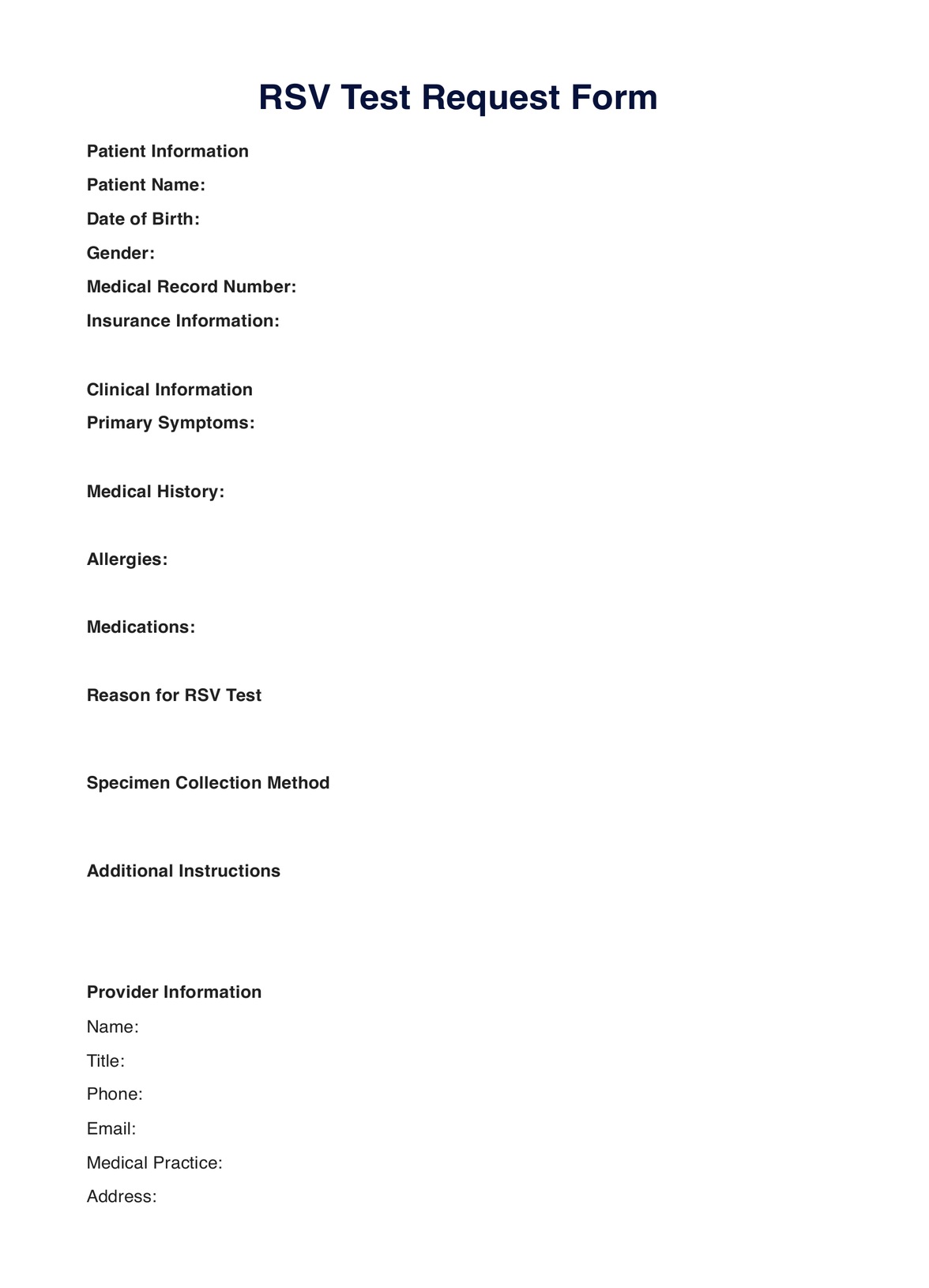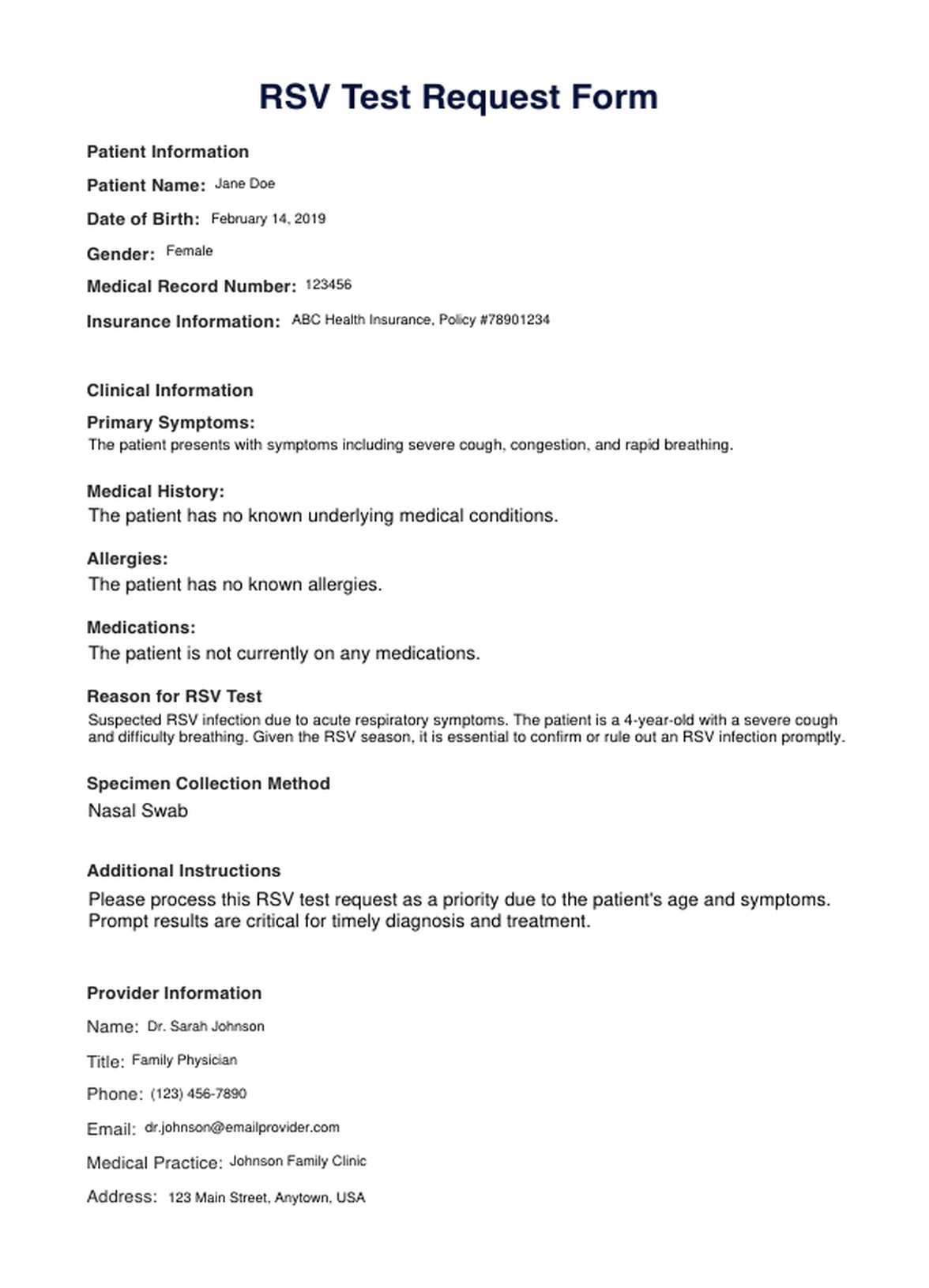RSV
Accurate RSV testing for early diagnosis. Learn about the Respiratory Syncytial Virus test and its importance in healthcare.


What Is an RSV Test?
An RSV test, short for Respiratory Syncytial Virus test, is a diagnostic tool for detecting RSV, a common respiratory virus that can cause cold-like symptoms in most people but poses severe risks to young children, older people, and those with weakened immune systems.
The RSV test is essential for several reasons:
- Early Diagnosis: It aids in the early identification of RSV infection, allowing for timely treatment and appropriate isolation measures to prevent the virus from spreading to others, especially in healthcare settings and among vulnerable populations.
- Differential Diagnosis: RSV symptoms overlap with those of other respiratory infections like influenza or common cold. Testing helps distinguish RSV from other illnesses, ensuring patients receive the most suitable care.
- Treatment Decisions: While RSV often resolves independently, it can be severe in certain populations. A positive test result may influence the treatment choice, such as antiviral medications or supportive care.
- Preventive Measures: Knowing if a patient has RSV can also guide preventive measures, as healthcare providers can take necessary precautions to prevent transmission, especially in neonatal and pediatric units.
The most common types of RSV tests are:
- Nasal Swab: A swab is inserted into the nasal passages to collect respiratory secretions. This is a relatively simple and non-invasive test, especially suitable for children.
- Throat Swab: Similar to a nasal swab, the sample is taken from the back of the throat. It may be more comfortable for some patients, especially older children and adults.
- Nasopharyngeal Aspirate: This method involves suctioning mucus from the back of the nose and throat. It's often used for young children and infants.
- Blood Test: Occasionally, a blood sample may be tested for RSV antibodies, which can indicate a current or recent infection.
The collected samples are then analyzed in a laboratory, typically using molecular techniques like polymerase chain reaction (PCR) to detect the virus's genetic material.
RSV Template
RSV Example
How Does It Work?
Clinical Assessment
A healthcare provider assesses the patient's symptoms and medical history to determine if an RSV test is necessary. Common symptoms include cough, congestion, and difficulty breathing.
Sample Collection
The healthcare provider collects a sample from the patient's respiratory tract. The most common methods for this include:
- Nasal Swab: A swab is gently inserted into the patient's nostril to collect mucus and other respiratory secretions.
- Throat Swab: Similar to a nasal swab, the sample is taken from the back of the throat.
- Nasopharyngeal Aspirate: The suction collects mucus from the back of the nose and throat. This is often used for infants and young children.
- Blood Test: Sometimes, a blood sample is taken to test for RSV antibodies.
Sample Handling
The collected sample is carefully stored and transported to a laboratory for analysis.
Laboratory Testing
In the lab, the sample is analyzed using techniques like Polymerase Chain Reaction (PCR). This method identifies and amplifies RSV genetic material, making detecting it easier.
Interpretation
The results are interpreted by trained laboratory staff. A positive result indicates the presence of RSV, while a negative result suggests its absence.
Reporting
The test results are reported to the healthcare provider, who shares them with the patient.
Treatment and Care
If the test is positive, the healthcare provider can recommend appropriate treatment, including antiviral medications or supportive care to alleviate symptoms.
The RSV test is vital for managing respiratory infections during the RSV season (usually late fall and winter). It enables early diagnosis, guides treatment decisions, and implements preventive measures for at-risk groups. Printable RSV test forms are commonly used in healthcare to document tests and results for records and reporting.
When Would You Use This Test?
The RSV test, or Respiratory Syncytial Virus test, is a valuable diagnostic tool for healthcare practitioners, especially during the fall and winter months. Its use is particularly pertinent in several scenarios:
- Pediatric Care: Pediatricians frequently use the RSV test when infants and young children present with cough, congestion, and breathing difficulties. RSV can cause severe respiratory distress in this age group, so an early diagnosis is essential for timely intervention.
- Elderly Patients: For geriatric healthcare providers, the RSV test is crucial when older adults exhibit respiratory symptoms. RSV can lead to pneumonia or exacerbate existing lung conditions, making its detection and management vital.
- Immunocompromised Patients: Patients with weakened immune systems, such as those undergoing chemotherapy or organ transplant recipients, are highly susceptible to RSV infections. An RSV test helps oncologists, transplant specialists, and other healthcare professionals diagnose and manage these cases effectively.
- Hospital Settings: In healthcare facilities, especially in neonatal and pediatric units, an RSV test is employed as part of infection control protocols. It's used to quickly identify RSV cases, allowing for isolation and implementing preventive measures to protect vulnerable patients.
- Primary Care: Family physicians and general practitioners may use the RSV test to rule out or confirm RSV infection when patients present with respiratory symptoms. This is important in ensuring patients receive appropriate care, such as antiviral treatment or supportive measures.
- Emergency Medicine: In emergency departments, the RSV test can be crucial for rapid diagnosis in cases of severe respiratory distress. It guides emergency physicians in making timely decisions on treatment and isolation to prevent further transmission.
- Research and Surveillance: Beyond clinical settings, researchers and public health authorities use the RSV test for surveillance and epidemiological studies to monitor RSV activity, especially during seasonal outbreaks.
What do the Results Mean?
Interpreting the results of an RSV test, which stands for Respiratory Syncytial Virus test, is crucial for determining the presence or absence of this virus in a patient's respiratory system. Common RSV test results and their interpretations are as follows:
- Positive Result: A positive RSV test indicates the presence of the Respiratory Syncytial Virus in the patient's respiratory tract. This means that the patient is currently infected with RSV. Healthcare providers will consider the patient's symptoms, medical history, and risk factors to determine the appropriate course of treatment. In high-risk populations like young children and older people, a positive result can be of particular concern, as RSV can lead to severe respiratory issues in these groups.
- Negative Result: A negative RSV test means the virus was not detected in the collected sample. However, it's important to note that a negative result does not rule out an RSV infection entirely. The test's sensitivity may vary, and the timing of the test about symptom onset can impact the accuracy. If a patient's symptoms strongly suggest RSV, a healthcare provider may order additional tests or consider clinical factors before reaching a final diagnosis.
- Indeterminate Result: In some cases, the test results may be inconclusive, which can occur due to issues with the sample quality or laboratory analysis. When this happens, the healthcare provider may recommend a retest or consider other diagnostic methods to confirm or rule out an RSV infection.
Understanding RSV test results is vital for healthcare providers to guide patient care, treatment choices, and infection control measures. Timely and precise diagnosis, particularly during the RSV season (typically late fall and winter), is critical for safeguarding vulnerable populations and limiting viral spread. Additionally, healthcare providers may consider other clinical considerations when interpreting results to ensure optimal patient care.

Research & Evidence
The Respiratory Syncytial Virus (RSV) test has a substantial history and a robust body of research and evidence supporting its use.
RSV was discovered in the early 1950s, and research efforts quickly began to understand its impact on human health. Early studies focused on characterizing the virus and its epidemiology.
Over the years, clinical validation studies have demonstrated the accuracy and reliability of RSV tests. These studies have shown that the test can effectively detect the virus in respiratory samples, aiding in early diagnosis and treatment.
Research has identified seasonal patterns in RSV infections, with outbreaks typically occurring in late fall and winter. This knowledge has been crucial in the timing of testing and preventive measures.
Research has consistently highlighted specific populations at higher risk of severe RSV infections, such as infants, the elderly, and immunocompromised individuals. These findings underscore the importance of timely testing in these groups.
Numerous studies have investigated the impact of RSV on healthcare settings. They have shown that RSV outbreaks can strain healthcare resources and increase hospitalization rates, making early detection through testing a priority.
Research has also contributed to the development and evaluation of antiviral treatments for RSV, further emphasizing the need for accurate diagnosis through testing.
Evidence-based guidelines have been established for implementing infection control measures in healthcare facilities during RSV outbreaks, driven by research on transmission and prevention.
Ongoing research is focused on developing RSV vaccines to reduce the burden of RSV infections. The RSV test plays a role in monitoring the effectiveness of these vaccines in clinical trials.
References
- Abels, S., Nadal, D., Stroehle, A., & Bossart, W. (2001). Reliable detection of respiratory syncytial virus infection in children for adequate hospital infection control management. Journal of Clinical Microbiology, 39(9), 3135–3139. https://doi.org/10.1128/jcm.39.9.3135-3139.2001
- Jant Pharmacal Corporation. (2022, November 10). QuickVue RSV Test (CLIA-Waived). JANT PHARMACAL CORPORATION. https://www.jantdx.com/product/quickvue-rsv-test-clia-waived/
- MSD Manuals. (n.d.). Lab-Test: Respiratory Syncytial Virus (RSV) Tests - MSD Manual Consumer Version. MSD Manual Consumer Version. https://www.msdmanuals.com/home/multimedia/lab-tests/respiratory-syncytial-virus-rsv-tests
- Park, A. (2023, September 25). Is it flu, COVID-19, or RSV? How to navigate the new world of At-Home testing. TIME. https://time.com/6316682/at-home-tests-covid-19-rsv-flu/
- Slinger, R., Milk, R., Gaboury, I., & Díaz‐Mitoma, F. (2004). Evaluation of the QuickLab RSV Test, a new rapid Lateral-Flow immunoassay for detection of respiratory syncytial virus antigen. Journal of Clinical Microbiology, 42(8), 3731–3733. https://doi.org/10.1128/jcm.42.8.3731-3733.2004
Commonly asked questions
Healthcare providers, including pediatricians, family physicians, and emergency room staff, typically request RSV tests for patients presenting with respiratory symptoms.
RSV tests are used when individuals, especially infants, young children, the elderly, and immunocompromised patients, exhibit symptoms like cough, congestion, and breathing difficulties, particularly during the RSV season, which typically occurs in late fall and winter.
RSV tests involve collecting respiratory samples through methods like nasal swabs, throat swabs, or blood tests. These samples are then analyzed in a laboratory using techniques like PCR to detect the virus.
The time it takes to get RSV test results can vary, but typically, results are available within a few hours to a day. However, it may take longer depending on the specific test, laboratory workload, and the location where the test is conducted.












-template.jpg)






























































































